
Helianthus is a genus comprising about 70 species of annual and perennial flowering plants in the daisy family Asteraceae commonly known as sunflowers. Except for three South American species, the species of Helianthus are native to North America and Central America. The best-known species is the common sunflower, whose round flower heads in combination with the ligules look like the Sun. This and other species, notably Jerusalem artichoke, are cultivated in temperate regions and some tropical regions as food crops for humans, cattle, and poultry, and as ornamental plants. The species H. annuus typically grows during the summer and into early fall, with the peak growth season being mid-summer.
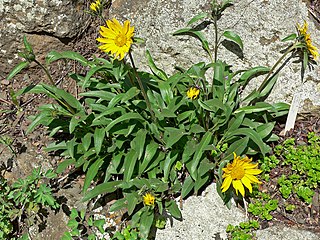
Helianthella castanea is a rare plant endemic to California, and is found only in the San Francisco Bay Area, mostly in the hills east of the bay, including in Mount Diablo State Park, Wildcat Canyon Regional Park, Briones Regional Park, Las Trampas Regional Wilderness, and surrounding areas. Its common names include Mount Diablo helianthella, Mount Diablo sunflower, and Diablo rockrose.

Pinus durangensis, the Durango pine, is a pine tree species endemic to the Sierra Madre Occidental mountain range of north-western Mexico.
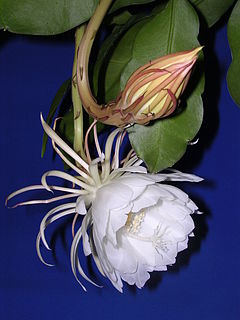
Epiphyllum oxypetalum, the Dutchman's pipe cactus, princess of the night or queen of the night, is a species of cactus. It rarely blooms and only at night, and its flowers wilt before dawn. Though it is sometimes referred to as a night-blooming cereus, it is not closely related to any of the species in the tribe Cereeae, such as Selenicereus, that are more commonly known as night-blooming cereus. All Cereus species bloom at night and are terrestrial plants; Epiphyllum species are usually epiphytic.

Ipomoea indica is a species of flowering plant in the family Convolvulaceae, known by several common names, including blue morning glory, oceanblue morning glory, koali awa, and blue dawn flower. It bears heart-shaped or 3-lobed leaves and purple or blue funnel-shaped flowers 6–8 cm (2–3 in) in diameter, from spring to autumn. The flowers produced by the plant are hermaphroditic. This plant has gained the Royal Horticultural Society's Award of Garden Merit.
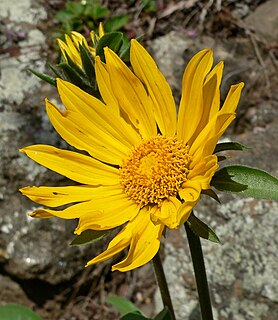
Helianthella, the little sunflower, is a genus of North American plants in the family Asteraceae.

Arbutus xalapensis, commonly known as the Texas madrone, naked Indian tree or Texas madroño, is a species of flowering plant in the heather family. It is native to Central America, the southwestern United States, and throughout Mexico. It is found in canyons and mountains, on rocky plains, and in oak woodlands, at altitudes of up to 3,000 m in the south of the range, but lower, down to 600 m in the north of the range.

Tillandsia caput-medusae is a species of flowering plant in the bromeliad family, Bromeliaceae, subfamily Tillandsioideae. Common names include octopus plant and medusa's head. An epiphyte native to Central America and Mexico, T. caput-medusae is a commonly cultivated bromeliad species. The thick, channeled, tapering and twisting leaves are up to 25 cm (9.8 in) long and are covered in fine gray hairs. The rosette of leaves arise from an inflated pseudobulb. Pups are produced after blooming, as is usual with most Tillandsia species.

Crinum asiaticum, commonly known as poison bulb, giant crinum lily, grand crinum lily, spider lily, is a plant species widely planted in many warmer regions as an ornamental. It is a bulb-forming perennial producing an umbel of large, showy flowers that are prized by gardeners. However, all parts of the plant are poisonous if ingested. Some reports indicate exposure to the sap may cause skin irritation.
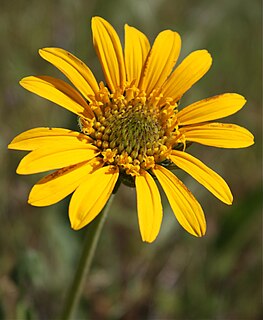
Helianthella californica is a species of flowering plant in the family Asteraceae known by the common name California helianthella. This wildflower is native to the mountains of California, northwestern Nevada, and southwestern Oregon.

Enceliopsis covillei, known by the common name Panamint daisy, is a rare North American desert species of flowering plant in the family Asteraceae.
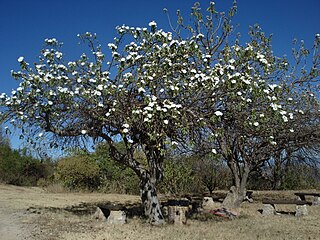
Ipomoea arborescens, the tree morning glory, is a rapidly-growing, semi-succulent flowering tree in the family Convolvulaceae. This tropical plant is mostly found in Mexico, and flowers in late autumn and winter. Its common name in Nahuatl is Cazahuatl or Cazahuate.
Stevia plummerae, or Plummer's candyleaf, is a plant species known from Arizona, New Mexico, Chihuahua, Sonora and Durango It is an herb up to 80 cm tall, with white, pink or red flowers. It tends to grow in pine forests at an elevation of 2,000–3,000 m (6,600–9,800 ft).
Solidago durangensis is very rare Mexican species of flowering plants in the family Asteraceae. It is known only from a few collections made in the 1890s near the city of Durango in northern Mexico, and not seen since. It is very likely now extinct.
Flourensia pringlei, common name Pringle's tarwort, is a species of flowering plant in the family Asteraceae. It is native to the States of Chihuahua and Durango in northern Mexico, the range extending just barely over the international border into Hidalgo County in southwestern New Mexico.
Galinsoga durangensis is a rare Mexican species of flowering plant in the family Asteraceae. It has been found in the States of Durango and Sinaloa in northwestern Mexico.
Helianthella microcephala, common name purpledisk helianthella, is a North American plant species in the family Asteraceae. It grows in the southwestern United States, in the states of Arizona, New Mexico, Colorado, and Utah.
Helianthella parryi, common name Parry's dwarf-sunflower, is a North American plant species in the family Asteraceae. It grows in the southwestern United States, in the States of Arizona, New Mexico, Colorado, and Utah.
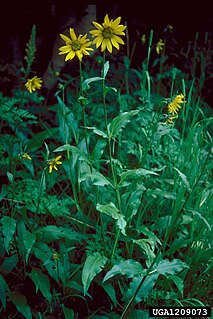
Helianthella quinquenervis, the fivenerve helianthella, is a North American plant species in the family Asteraceae. It grows in the mountains of the western United States and northern Mexico. This include the Rockies, the Black Hills, the ranges of the Great Basin, and the northern Sierra Madre, from Montana, Oregon, and South Dakota south as far as western Chihuahua and Coahuila.
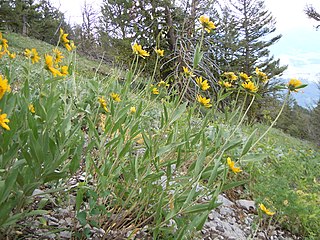
Helianthella uniflora, the oneflower helianthella, is a North American plant species in the family Asteraceae. It grows in the western United States and western Canada. It has been found from British Columbia south as far as northern Arizona and northern New Mexico.













